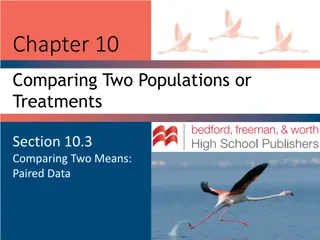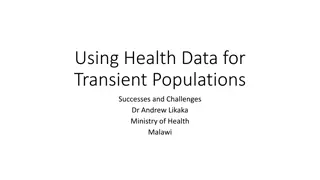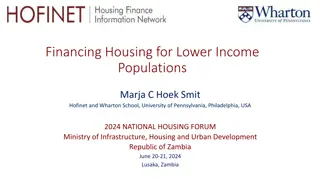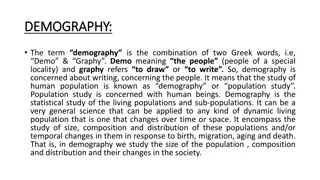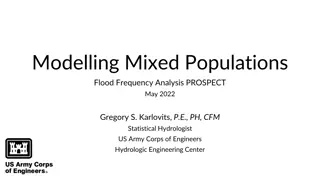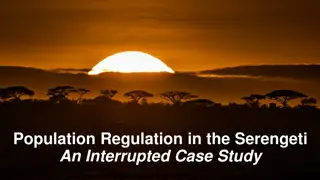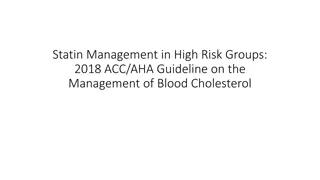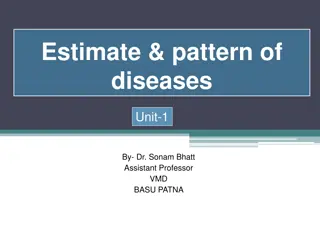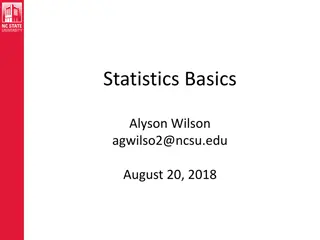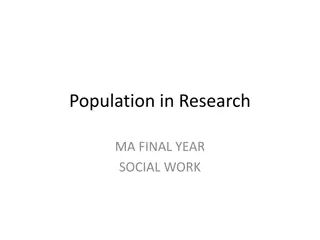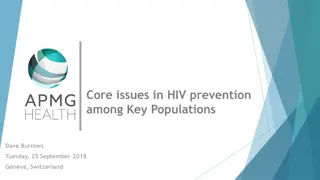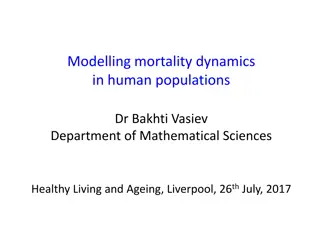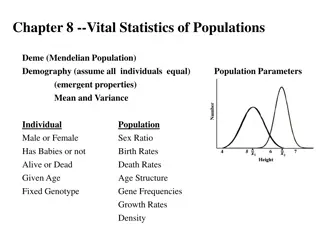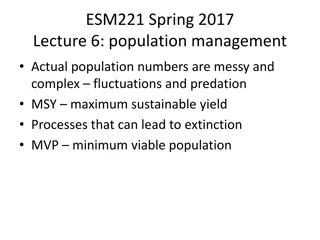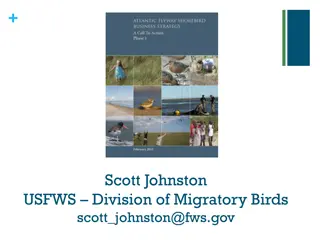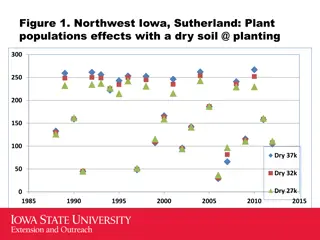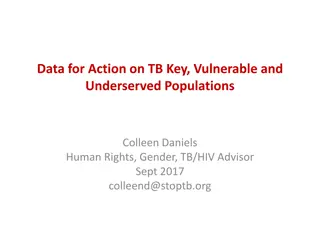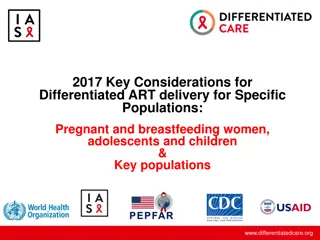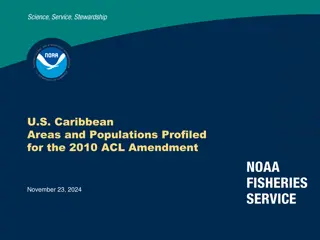Zero Tolerance Initiative: Protecting Florida's Vulnerable Populations
The Agency for Persons with Disabilities (APD) in Florida is dedicated to supporting individuals with developmental disabilities and combatting abuse, neglect, and exploitation. Through their Zero Tolerance Initiative and community efforts, they aim to empower individuals to report incidents and bre
4 views • 29 slides
Healthcare Expansion Strategy in Prince George County VA
Our organization aims to expand healthcare services in Prince George County VA, where there is currently a gap in hospital facilities. By analyzing the competition and patient populations served by existing hospitals like SRMC and JRMC, we plan to tailor our services to meet the needs of high-risk,
0 views • 15 slides
Community-Based Participatory Research for Hard-to-Reach Populations: A Collaborative Approach
This presentation focuses on community-based participatory research for hard-to-reach populations, particularly on implementing harm reduction strategies for amphetamine-type stimulant (ATS) use. It addresses community engagement, outreach to hidden sites, societal perceptions of drug use, and the c
0 views • 25 slides
Fostering Openness in ODL for Marginalized Students
Student access and success in universities, especially for marginalized populations, is a complex issue in South Africa. This study by Dr. Alice Mkuzangwe from the University of South Africa explores the dimensions of openness in Open and Distance Learning (ODL) and identifies factors affecting marg
1 views • 29 slides
Understanding Species Interactions and Predator-Prey Dynamics
Species interactions refer to the associations between different organisms that can be positive or negative, influencing the growth and evolution of populations. Predation is a key interaction where one organism hunts and feeds on another. In predator-prey dynamics, populations fluctuate in a cyclic
3 views • 36 slides
Chapter 10.Comparing Two Populations or Treatments
In a study of identical twins raised in high-income and low-income households, researchers compared IQ scores between the siblings. The analysis revealed that twins from high-income households had a higher mean IQ of 109.5 compared to 103.667 for those raised in low-income households. Although there
9 views • 52 slides
Enhancing Health Data Usage for Transient Populations in Malawi
Exploring the challenges and successes in using health data for transient populations in Malawi, this presentation covers migration trends, potential opportunities, and recommendations for data use and exchange. Case studies illustrate the complexities of managing health data for mobile populations,
1 views • 15 slides
Financing Housing for Lower Income Populations - Insights and Challenges
Recent global developments in housing finance, investment opportunities, challenges faced by mortgage lenders in serving underserved market segments, funding cost issues, impact of inflation and monetary tightening on house prices, and regulatory restrictions affecting affordability are discussed in
0 views • 27 slides
Understanding Demography: Study of Human Population Trends
Demography, derived from Greek words meaning "people" and "to write," is the statistical study of living populations and sub-populations. It involves analyzing population size, composition, distribution, and changes in response to factors like birth, migration, aging, and death. Demographers collect
0 views • 51 slides
FDA Perspective on Epidemiological Cut-off Values (ECVs)
The FDA presents insights on the development and use of Epidemiological Cut-off Values (ECVs) to distinguish wild-type populations from those with acquired resistance mechanisms. ECVs are crucial for determining antimicrobial susceptibility and guiding treatment decisions. The process involves analy
0 views • 13 slides
Shark Conservation Quiz Play - Test Your Knowledge on Protecting Shark Populations
Test your knowledge on shark conservation by playing this quiz. Learn about the main ways to protect shark populations, including Marine Protected Areas (MPAs) and fisheries regulations. Discover the significance of Marine Protect Areas (MPAs) and the importance of data collection in species protect
0 views • 26 slides
Understanding Populations: Factors Affecting Growth and Dynamics
In the study of populations, factors like carrying capacity, density-dependent, and density-independent growth play crucial roles. Learn about estimating population size, dispersion patterns, growth rates, and more to understand how populations change over time.
0 views • 25 slides
Environmental Challenges Facing the Great Barrier Reef
The management of the Great Barrier Reef has faced significant challenges leading to a decline in coral cover, dugong populations, seagrass health, and shark populations. Issues such as fishing practices, terrestrial pollutant runoff, and climate change have contributed to the deterioration of the r
0 views • 16 slides
Importance of Diversity in Healthcare Workforce
The importance of recruiting and retaining a diverse workforce in healthcare is highlighted through the benefits it brings, such as improved patient outcomes for diverse populations and enhanced cultural competence. Diversity helps address disparities in healthcare experienced by racial and ethnic m
1 views • 37 slides
Understanding Mixed Populations in Flood Frequency Analysis
In this presentation by Gregory S. Karlovits, P.E., PH, CFM, a statistical hydrologist from the US Army Corps of Engineers, the focus is on modelling mixed populations in flood frequency analysis. The key topics include revisiting the IID assumption, identifying mixed populations, and building model
0 views • 38 slides
Understanding Special Populations Students in CTE Programs
Special Populations Students in Career and Technical Education (CTE) programs include individuals with disabilities, economically disadvantaged individuals, single parents, English Language Learners, migrants, homeless individuals, and more. These students may require Individualized Education Progra
0 views • 9 slides
Population Regulation in the Serengeti: An Interrupted Case Study
Explore the fascinating dynamics of population regulation in the Serengeti National Park through a series of slides covering factors influencing wildlife populations, such as bottom-up and top-down controls, density-dependent and independent factors, and the impact of diseases like rinderpest on mig
0 views • 20 slides
Sexual Health Promotion Strategies for Vulnerable Populations
Explore sexual health promotion strategies and referral processes for vulnerable young people, adults, and populations at increased risk of poor sexual health outcomes. Learn about the importance of self-awareness, brief interventions, effective contraception methods, and onward referrals to special
0 views • 20 slides
Guideline for Statin Management in High-Risk Groups - 2018 ACC/AHA
This guideline outlines the management of blood cholesterol in high-risk groups according to the 2018 ACC/AHA recommendations. It discusses the overall approach, different statin management groups, justification for statin use in high-risk populations, high and moderate-intensity statin therapy, and
1 views • 14 slides
Understanding Disease Patterns in Epidemiology: Overview and Examples
Epidemiology is the study of health event distribution in populations. This includes analyzing disease patterns by time, place, and affected individuals. Diseases can be sporadic, endemic, epidemic, or pandemic, each with distinct occurrence characteristics. Understanding disease prevalence and inci
0 views • 9 slides
Understanding Populations in Homelessness and Poverty Presentation
This presentation by the Community Transportation Association of the Northwest, presented by Ryan Acker, delves into the importance of understanding homelessness and poverty. It highlights the challenges faced by vulnerable populations, such as homeless individuals, those living in poverty, people w
0 views • 53 slides
Understanding Central Place Theory: Key Concepts and Determinants
Central Place Theory (CPT) attempts to explain the spatial arrangement, size, and number of settlements based on central places, zones of influence, and hinterlands. This theory, introduced by Walter Christaller in 1933, outlines the importance of central functions, threshold populations, and factor
0 views • 12 slides
Utilizing Sterile Insect Technique for Aedes Aegypti Control
The Sterile Insect Technique (SIT) is a biologically-based method used to manage key insect pests by releasing sterile insects to decrease population reproduction. This technique, developed through genetic manipulation and ionizing radiation, has been instrumental in controlling insect populations l
0 views • 13 slides
Understanding Ecological Organization in the Environment
Explore the relationships among organisms within populations, communities, ecosystems, and biomes. Delve into the levels of organization in different environments, from populations to the biosphere. Learn about primary and secondary succession, pioneer species, and how environments form. Discover th
1 views • 19 slides
Understanding Basic Concepts in Statistics
This content covers fundamental concepts in statistics such as populations, samples, models, and probability distributions. It explains the differences between populations and samples, the importance of models in describing populations, and discusses various distributions like the normal and Poisson
0 views • 42 slides
Optimizing Antiretroviral Therapy Delivery for Specific Populations
Tailored antiretroviral therapy (ART) delivery models benefit stable patients by addressing inequities and involving key populations. Differentiated care extends to adolescents, pregnant women, and key populations, emphasizing psychosocial support. Transitioning between client categories is crucial
0 views • 6 slides
Understanding the Concept of Population and Unit Stock
The concept of population revolves around all organisms of the same species living in a specific area capable of interbreeding. It is essential to differentiate between sample populations and real populations to accurately study their attributes such as birth rates, death rates, and spatial dimensio
0 views • 15 slides
Understanding Research Populations in Social Work Studies
Research populations in social work studies play a crucial role in forming the basis for data collection and analysis. The definition, types (target and accessible populations), and challenges faced by researchers in testing entire populations are explored in this informative content.
0 views • 5 slides
Core Issues in HIV Prevention Among Key Populations
Understanding the challenges in HIV prevention among key populations, such as gay men, sex workers, people who inject drugs, transgender individuals, and prisoners. Highlighted are the increased risks of HIV acquisition within these groups and the importance of tailored service packages recommended
0 views • 24 slides
Mortality Dynamics in Human Populations: Modeling Trends and Patterns
Explore the dynamics of mortality in human populations through concepts like Gompertz Law, Compensation Effect, and Late-life Deceleration. Discover how mathematical models help analyze mortality data, predict future trends, and guide research for healthier aging.
0 views • 17 slides
Higher Premium Impact on Older and Low-Income Populations Under BCRA
Premium comparisons reveal that low-income, older adults face substantial increases in premiums under the Senate BCRA compared to the ACA. States with older, lower-income, and rural populations would experience over 100% higher average premiums under the BCRA. The BCRA could result in significant di
2 views • 5 slides
Understanding Vital Population Statistics and Demography
Exploring vital statistics of populations with a focus on Mendelian populations and demography, analyzing factors like sex ratio, birth rates, death rates, age structure, gene frequencies, growth rates, and population density. The content delves into emergent properties, mean and variance population
0 views • 9 slides
Population Management and Sustainable Harvesting Strategies
Actual population numbers exhibit complex fluctuations influenced by predation and other factors. Understanding concepts like Maximum Sustainable Yield (MSY) and Minimum Viable Population (MVP) can help in managing populations effectively. The concept of MSY ensures the maximum harvest of a renewabl
0 views • 32 slides
Understanding Special Populations Students in CTE Programs
Students who have special learning needs are considered special populations students in CTE programs. They include individuals with disabilities, economically disadvantaged individuals, single parents, English Language Learners, migrants, homeless individuals, youth in foster care, and youth with pa
0 views • 9 slides
Understanding Aquatic Epidemiology in Fish Populations
Aquatic epidemiology is a crucial branch of science that focuses on describing the health, diseases, and welfare of fish populations. It involves studying diseases in wild and hatchery-raised fish, identifying factors influencing disease occurrence, and conducting diagnostic investigations to mainta
0 views • 12 slides
Addressing the Decline of Shorebird Populations in the Atlantic Flyway
The presentation focuses on the concerning decline in shorebird populations within the Atlantic Flyway, emphasizing the urgency for increased conservation efforts. It highlights specific species affected by the decline and proposes a comprehensive business strategy involving multiple partners to rev
0 views • 10 slides
Analysis of Plant Populations Effects in Various Regions of Iowa
The figures depict the impact of plant populations on yield in different regions of Iowa under dry soil conditions. The data spans several years, showing trends in plant populations and corresponding yields over time. Each figure focuses on a specific region, providing insights into agricultural pra
0 views • 8 slides
Understanding and Prioritizing Tuberculosis Key Populations for Action
This collection of resources explores the identification, understanding, and prioritization of key populations affected by tuberculosis (TB), focusing on vulnerable and underserved communities. It delves into the framework for structuring programs, factors contributing to disease burden, and a range
0 views • 8 slides
Key Considerations for Differentiated ART Delivery for Specific Populations
This collection of resources discusses key factors in differentiated approaches to HIV care, focusing on pregnant and breastfeeding women, adolescents, children, and key populations such as people who inject drugs, sex workers, men who have sex with men, transgender individuals, and those in prisons
0 views • 14 slides
U.S. Caribbean Areas & Populations 2010 Profile: Amendment Overview
The presentation outlines mandates under NEPA and Magnuson-Stevens Act for considering affected populations in U.S. Caribbean areas. It covers demographics, poverty rates, and racial populations, focusing on St. Croix, St. Thomas/St. John, and Puerto Rico.
0 views • 38 slides





